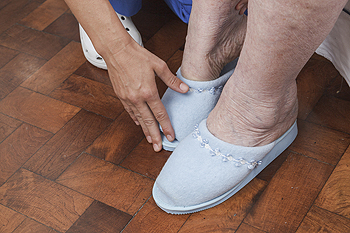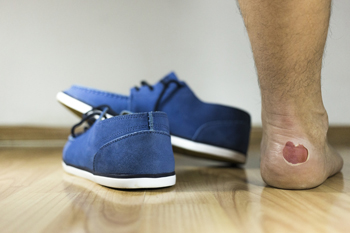Merrillville, IN
Munster, IN
November 2023
How Aging Can Affect Your Feet

As time passes, the body undergoes natural changes, and our feet are no exception. Subjected to a lifetime of impact, weight-bearing and pressure, your feet gradually transform, affecting their strength and resilience. One noticeable change brought on by aging is the thinning of the skin, reducing natural cushioning and making the feet more vulnerable to damage. Joints in the feet undergo wear and tear, leading to conditions like osteoarthritis. Joints become less flexible, causing the foot to lose its springiness and ability to absorb impact. Muscle strength, which peaked in your 20s and early 30s, gradually diminishes with age. Regular exercise slows this decline and helps to maintain overall foot health. Swelling, a common issue with age, increases pressure on the foot's structures. Poor circulation, often associated with conditions such as atherosclerosis, affects the blood supply to the feet and reduces their ability to repair minor injuries quickly. Toenails also undergo changes, becoming thicker and more brittle as growth slows. Conditions like hypothyroidism and peripheral arterial disease can make this worse. For help in managing foot problems associated with aging, it is suggested that you make an appointment with a podiatrist.
Proper foot care is something many older adults forget to consider. If you have any concerns about your feet and ankles, contact Ahmad Elsamad, DPM from The Institute of Foot & Ankle Reconstructive Surgery . Our doctor can provide the care you need to keep you pain-free and on your feet.
The Elderly and Their Feet
As we age we start to notice many changes in our body, but the elder population may not notice them right away. Medical conditions may prevent the elderly to take notice of their foot health right away. Poor vision is a lead contributor to not taking action for the elderly.
Common Conditions
- Neuropathy – can reduce feeling in the feet and can hide many life-threatening medical conditions.
- Reduced flexibility – prevents the ability of proper toenail trimming, and foot cleaning. If left untreated, it may lead to further medical issues.
- Foot sores – amongst the older population can be serious before they are discovered. Some of the problematic conditions they may face are:
- Gouging toenails affecting nearby toe
- Shoes that don’t fit properly
- Pressure sores
- Loss of circulation in legs & feet
- Edema & swelling of feet and ankles
Susceptible Infections
Diabetes and poor circulation can cause general loss of sensitivity over the years, turning a simple cut into a serious issue.
If you have any questions please feel free to contact our offices located in Merrillville, and Munster, IN . We offer the newest diagnostic and treatment technologies for all your foot and ankle needs.
Teen Foot Blisters

Teenagers often develop foot blisters due to friction, which can be the result of wearing new or ill-fitting shoes, engaging in high-intensity activities, or having sweaty feet. The best way to manage these blisters is to keep them clean with gentle soap and water and to protect them with a sterile bandage or specialized blister plaster that can cushion the area and soak up excess moisture. It is crucial not to pop blisters, as the skin covering them acts as a protective barrier against infection. Should a blister break on its own, the area should be cleaned, an antibiotic ointment applied, and then re-covered with a clean bandage. Ensuring footwear fits correctly and socks are moisture-wicking will help prevent further irritation. In cases where blisters are particularly painful, keep reoccurring, or show signs of infection, it is suggested that you make an appointment with a podiatrist who can provide additional treatment and prevention strategies.
Blisters may appear as a single bubble or in a cluster. They can cause a lot of pain and may be filled with pus, blood, or watery serum. If your feet are hurting, contact Ahmad Elsamad, DPM of The Institute of Foot & Ankle Reconstructive Surgery . Our doctor can provide the care you need to keep you pain-free and on your feet.
Foot Blisters
Foot blisters are often the result of friction. This happens due to the constant rubbing from shoes, which can lead to pain.
What Are Foot Blisters?
A foot blister is a small fluid-filled pocket that forms on the upper-most layer of the skin. Blisters are filled with clear fluid and can lead to blood drainage or pus if the area becomes infected.
Symptoms
(Blister symptoms may vary depending on what is causing them)
- Bubble of skin filled with fluid
- Redness
- Moderate to severe pain
- Itching
Prevention & Treatment
In order to prevent blisters, you should be sure to wear comfortable shoes with socks that cushion your feet and absorb sweat. Breaking a blister open may increase your chances of developing an infection. However, if your blister breaks, you should wash the area with soap and water immediately and then apply a bandage to the affected area. If your blisters cause severe pain it is important that you call your podiatrist right away.
If you have any questions, please feel free to contact our offices located in Merrillville, and Munster, IN . We offer the newest diagnostic and treatment technologies for all your foot care needs.
Foot Conditions Caused by Pregnancy

Pregnancy is a transformative journey, both physically and emotionally. While many anticipate changes in their bodies, some may not be aware of the potential foot conditions that can arise during this time. One common issue is edema, or swelling of the feet and ankles, which results from increased blood volume and the pressure on leg veins. This can cause discomfort, but it is often temporary. Another condition linked to pregnancy is flat feet. Hormonal changes during pregnancy can affect the ligaments in the feet, leading to a decrease in arch height. This can contribute to foot pain and discomfort. Additionally, weight gain can place added stress on the feet, often causing pain and fatigue. The expanding uterus may also shift the center of gravity, altering the gait and potentially causing problems like plantar fasciitis. Pregnancy can bring about various foot challenges, but with proper care, many of these issues can be managed or prevented. If you have developed any type of foot conditions during your pregnancy, it is suggested that you schedule an appointment with a podiatrist who can monitor any foot pain or discomfort you may be experiencing.
Pregnant women with swollen feet can be treated with a variety of different methods that are readily available. For more information about other cures for swollen feet during pregnancy, consult with Ahmad Elsamad, DPM from The Institute of Foot & Ankle Reconstructive Surgery . Our doctor will attend to all of your foot and ankle needs.
What Foot Problems Can Arise During Pregnancy?
One problem that can occur is overpronation, which occurs when the arch of the foot flattens and tends to roll inward. This can cause pain and discomfort in your heels while you’re walking or even just standing up, trying to support your baby.
Another problem is edema, or swelling in the extremities. This often affects the feet during pregnancy but tends to occur in the later stages.
How Can I Keep My Feet Healthy During Pregnancy?
- Wearing orthotics can provide extra support for the feet and help distribute weight evenly
- Minimize the amount of time spent walking barefoot
- Wear shoes with good arch support
- Wear shoes that allow for good circulation to the feet
- Elevate feet if you experience swelling
- Massage your feet
- Get regular, light exercise, such as walking, to promote blood circulation to the feet
If you have any questions please feel free to contact our offices located in Merrillville, and Munster, IN . We offer the newest diagnostic and treatment technologies for all your foot and ankle needs.
What Is an Ankle Sprain?

Ankle sprains are a common and painful injury that can happen to anyone, at any time. These injuries occur when the ligaments that support the ankle are stretched or torn due to sudden or excessive twisting or rolling of the foot. The most frequent cause of an ankle sprain is a misstep, such as stepping on an uneven surface or making a sudden change in direction during physical activities. The symptoms of an ankle sprain are typically immediate and can range from mild to severe. Pain, swelling, and bruising around the affected ankle are common signs. Mobility may be restricted, and the ankle may feel unstable or weak. In more severe cases, a popping or tearing sensation may be felt at the time of injury. Understanding the causes and symptoms of ankle sprains can help individuals take the necessary precautions to protect their ankles and reduce the risk of injury. If you have endured an ankle sprain, it is suggested that you contact a podiatrist who can accurately diagnose and treat this condition.
Ankle sprains are common but need immediate attention. If you need your feet checked, contact Ahmad Elsamad, DPM from The Institute of Foot & Ankle Reconstructive Surgery . Our doctor can provide the care you need to keep you pain-free and on your feet.
How Does an Ankle Sprain Occur?
Ankle sprains take place when the ligaments in your ankle are torn or stretched beyond their limits. There are multiple ways that the ankle can become injured, including twisting or rolling over onto your ankle, putting undue stress on it, or causing trauma to the ankle itself.
What Are the Symptoms?
- Mild to moderate bruising
- Limited mobility
- Swelling
- Discoloration of the skin (depending on severity)
Preventing a Sprain
- Wearing appropriate shoes for the occasion
- Stretching before exercises and sports
- Knowing your limits
Treatment of a Sprain
Treatment of a sprain depends on the severity. Many times, people are told to rest and remain off their feet completely, while others are given an air cast. If the sprain is very severe, surgery may be required.
If you have suffered an ankle sprain previously, you may want to consider additional support such as a brace and regular exercises to strengthen the ankle.
If you have any questions please feel free to contact our offices located in Merrillville, and Munster, IN . We offer the newest diagnostic and treatment technologies for all your foot and ankle needs.








